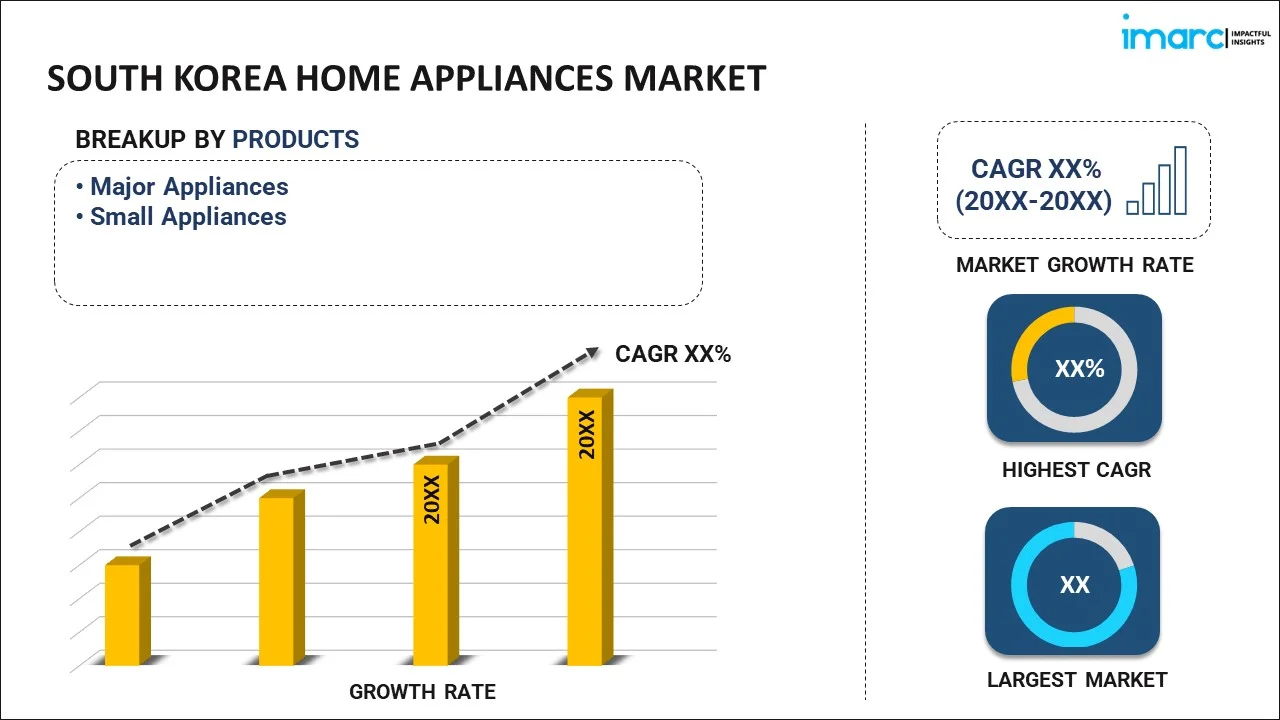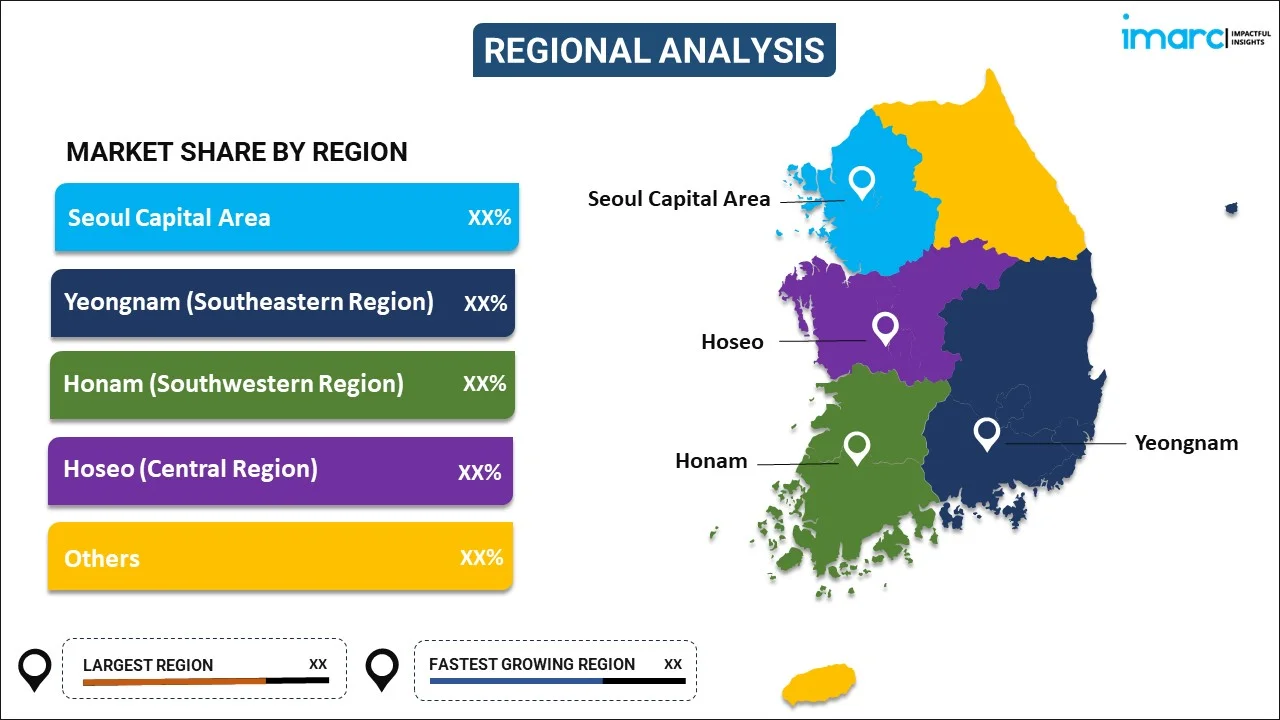
South Korea Home Appliances Market Report by Product (Major Appliances, Small Appliances), Distribution Channel (Supermarkets and Hypermarkets, Specialty Stores, E-commerce, and Others), and Region 2025-2033
Market Overview:
South Korea home appliances market size reached USD 12.2 Billion in 2024. Looking forward, IMARC Group expects the market to reach USD 15.2 Billion by 2033, exhibiting a growth rate (CAGR) of 2.5% during 2025-2033. The growing adoption of environmentally friendly and technologically advanced appliances, changing consumer preferences, and constant stream of product launches due to intensive competition among leading players represent some of the key factors driving the market.
|
Report Attribute
|
Key Statistics
|
|---|---|
|
Base Year
|
2024 |
|
Forecast Years
|
2025-2033
|
|
Historical Years
|
2019-2024
|
| Market Size in 2024 | USD 12.2 Billion |
| Market Forecast in 2033 | USD 15.2 Billion |
| Market Growth Rate (2025-2033) | 2.5% |
Home appliances encompass a wide range of devices designed to simplify daily tasks. They streamline processes, save time, and improve the overall functionality of homes and workplaces. Home appliances, commonly known as household appliances, are electrical or mechanical devices created for use within residences, aimed at facilitating various domestic tasks and enhancing daily life's convenience and comfort. These appliances constitute an essential component of contemporary households and fulfill a diverse range of functions. Typical home appliances encompass refrigerators, washing machines, ovens, microwaves, vacuum cleaners, air conditioners, dishwashers, and more. Each of these appliances is meticulously designed to execute specific tasks, such as food preservation, laundry cleaning, cooking, or maintaining optimal indoor conditions. The significance of home appliances extends beyond merely simplifying household chores; they also contribute significantly to energy conservation, time management, and an overall enhancement in the quality of life. They have become an integral aspect of modern living, allowing individuals and families to efficiently manage their homes and relish a more comfortable and convenient lifestyle.
South Korea Home Appliances Market Trends:
The market is primarily driven by the changing consumer preferences, rapid urbanization and the increasing number of consumers living in smaller spaces and apartments. Furthermore, the rising government's initiatives and regulations promoting energy efficiency have played a significant role in encouraging the adoption of environmentally friendly and technologically advanced appliances, thereby influencing the overall market. Also, the market is witnessing an increasing preference for smart appliances that offer connectivity and automation, enabling consumers to remotely control and monitor their devices, which is acting as another growth-inducing factor. Moreover, continuous innovation in product design, features, and smart technology integration that impel consumers to buy appliances that offer cutting-edge features and connectivity has been a major driving factor. With growing environmental consciousness and rising energy costs, energy-efficient appliances are in high demand. South Korean consumers prioritize appliances with high energy efficiency ratings, which has driven manufacturers to develop eco-friendly and cost-effective options, further impacting the market. Apart from this, intense competition among home appliance manufacturers in South Korea has led to a constant stream of product launches and advancements. This competition benefits consumers by offering a wide range of choices and driving product improvement, this is providing an impetus to the market. Other factors, including rapid industrialization, the aging population, increasing awareness among the masses regarding innovative home appliances, continual improvements in the e-commerce industry, are also positively influencing the market.
South Korea Home Appliances Market Segmentation:
IMARC Group provides an analysis of the key trends in each segment of the market, along with forecasts at the country level for 2025-2033. Our report has categorized the market based on product and distribution channel.
Product Insights:

- Major Appliances
- Refrigerators
- Freezers
- Dishwashing Machines
- Washing Machines
- Cookers and Ovens
- Small Appliances
- Vacuum Cleaners
- Toasters
- Grills and Roasters
- Coffee/Tea Makers
- Mixers and Grinders
- Others
The report has provided a detailed breakup and analysis of the market based on the product. This includes major appliances (refrigerators, freezers, dishwashing machines, washing machines, and cookers and ovens) and small appliances (vacuum cleaners, toasters, grills and roasters, coffee/tea makers, mixers and grinders, and others).
Distribution Channel Insights:
- Supermarkets and Hypermarkets
- Specialty Stores
- E-commerce
- Others
A detailed breakup and analysis of the market based on the distribution channel have also been provided in the report. This includes supermarkets and hypermarkets, specialty stores, e-commerce, and others.
Regional Insights:

- Seoul Capital Area
- Yeongnam (Southeastern Region)
- Honam (Southwestern Region)
- Hoseo (Central Region)
- Others
The report has also provided a comprehensive analysis of all the major regional markets, which include Seoul Capital Area, Yeongnam (Southeastern Region), Honam (Southwestern Region), Hoseo (Central Region), and Others.
Competitive Landscape:
The market research report has also provided a comprehensive analysis of the competitive landscape in the market. Competitive analysis such as market structure, key player positioning, top winning strategies, competitive dashboard, and company evaluation quadrant has been covered in the report. Also, detailed profiles of all major companies have been provided.
South Korea Home Appliances Market Report Coverage:
| Report Features | Details |
|---|---|
| Base Year of the Analysis | 2024 |
| Historical Period | 2019-2024 |
| Forecast Period | 2025-2033 |
| Units | Billion USD |
| Scope of the Report | Exploration of Historical and Forecast Trends, Industry Catalysts and Challenges, Segment-Wise Historical and Predictive Market Assessment:
|
| Products Covered |
|
| Distribution Channels Covered | Supermarkets and Hypermarkets, Specialty Stores, E-commerce, Others |
| Regions Covered | Seoul Capital Area, Yeongnam (Southeastern Region), Honam (Southwestern Region), Hoseo (Central Region), Others |
| Customization Scope | 10% Free Customization |
| Post-Sale Analyst Support | 10-12 Weeks |
| Delivery Format | PDF and Excel through Email (We can also provide the editable version of the report in PPT/Word format on special request) |
Key Questions Answered in This Report:
- How has the South Korea home appliances market performed so far and how will it perform in the coming years?
- What has been the impact of COVID-19 on the South Korea home appliances market?
- What is the breakup of the South Korea home appliances market on the basis of product?
- What is the breakup of the South Korea home appliances market on the basis of distribution channel?
- What are the various stages in the value chain of the South Korea home appliances market?
- What are the key driving factors and challenges in the South Korea home appliances?
- What is the structure of the South Korea home appliances market and who are the key players?
- What is the degree of competition in the South Korea home appliances market?
Key Benefits for Stakeholders:
- IMARC’s industry report offers a comprehensive quantitative analysis of various market segments, historical and current market trends, market forecasts, and dynamics of the South Korea home appliances market from 2019-2033.
- The research report provides the latest information on the market drivers, challenges, and opportunities in the South Korea home appliances market.
- Porter's five forces analysis assist stakeholders in assessing the impact of new entrants, competitive rivalry, supplier power, buyer power, and the threat of substitution. It helps stakeholders to analyze the level of competition within the South Korea home appliances industry and its attractiveness.
- Competitive landscape allows stakeholders to understand their competitive environment and provides an insight into the current positions of key players in the market.
Need more help?
- Speak to our experienced analysts for insights on the current market scenarios.
- Include additional segments and countries to customize the report as per your requirement.
- Gain an unparalleled competitive advantage in your domain by understanding how to utilize the report and positively impacting your operations and revenue.
- For further assistance, please connect with our analysts.
 Inquire Before Buying
Inquire Before Buying
 Speak to an Analyst
Speak to an Analyst
 Request Brochure
Request Brochure
 Request Customization
Request Customization




.webp)




.webp)












